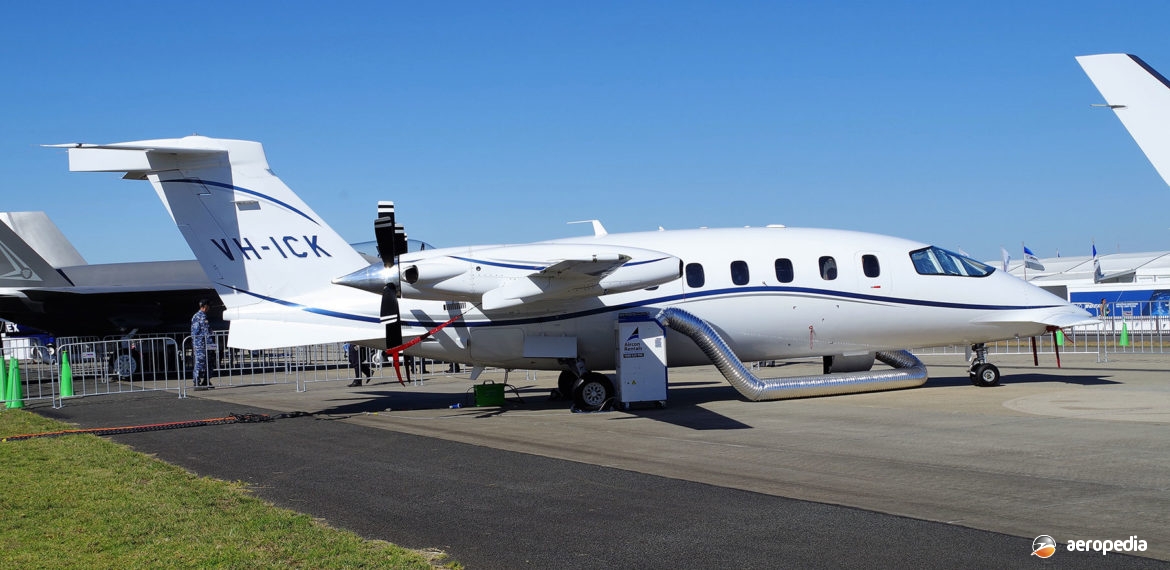Photograph:
Piaggio P-180 Avanti VH-ICK (c/n 1155) at the Australian International Airshow at Avalon, VIC in 2017 (David C Eyre)
Country of origin:
Italy
Description:
Business and executive aircraft
Power Plant:
Two 634 kw (850 shp) Pratt & Whitney PT6A-66 turboprops
Specifications:
- Wingspan: 13.84 m (45 ft 5 in)
- Span of foreplane: 3.28 m (10 ft 9¼ in)
- Length: 14.17 m (46 ft 5¾ in)
- Height: 3.90 m (12 ft 8 in)
- Wing area: 15.76 m² (169.64 sq ft)
- Max cruising speed at 8,230 m (27,000 ft): 740 km/h (460 mph)
- Economical cruising speed at 12,500 m (41,000 ft): 593 km/h (368 mph)
- Initial rate of climb: 1,113 m/min (3,650 ft/min)
- Certificated operational ceiling: 12,495 m (41,000 ft)
- Single-engine ceiling: 9,750 m (32,000 ft)
- Take-off distance to 15 m (50 ft): 736 m (2,415 ft)
- Landing distance from 15 m (50 ft): 759 m (2,490 ft)
- Range with IFR reserves with four passengers: 3,335 km (2,072 miles)
- Empty weight: 3,130 kg (6,900 lb)
- Max fuel load: 1,224 kg (2,700 lb)
- Max payload: 907 kg (2,000 lb)
- Max take-off weight: 4,767 kg (10,510 lb)
- Max landing weight: 4,529 kg (9,985 lb)
History:
The Avanti is of unusual design and is a mid-wing, three flying-surface aircraft designed to provide minimal drag and fuel consumption at the speed of a jet aircraft, keeping the main spar and engines behind the cabin to reduce noise, with a roomy cabin with good internal space, having a wide centre of gravity range. The wing was designed by the Ohio State University and was refined in wind tunnel testing. The front wing has five degrees of anhedral to prevent wake interference. Power is supplied by two Pratt & Whitney Canada PT6A-66 turboprops flat rated to 634 kw (850 hp) for take-off up to 8,230 m (27,000 ft) driving Hartzell counter-rotating, constant speed feathering and reversing, five or six-blade propellers 2.6 m (7 ft 1 in) in diameter.
The aircraft has a smooth exterior skin and is 80 per cent constructed of aluminium. Only the radome, forward wing, engine nacelles, flaps, undercarriage doors, baggage door, tail cone and fin are constructed from composites. The prototype (I-PJAV) flew on 23 September 1986 from the Company’s Genoa facility, being followed by a second prototype (I-PJAR) on 14 May 1987, the first production machine (c/n NC1004) being flown on 5 May 1990. Italian certification was received on 7 March 1990 and it has been certificated to FAR 23 transport category which includes day and night flight, VFR and IFR conditions and limited soft-field operations.
On 11 January 1993 a P-180 demonstrator left Genoa and flew to Japan via Egypt, Saudi Arabia, India, Thailand and The Philippines and made a 35-day Far East sales tour. Companies involved with the production of the type have included Gates Learjet, which was responsible for systems development and to handle a part of the production, a new facility being set-up at Midcontinent Airport, Wichita; and Sikorsky was sub-contracted to produce composite items. A mock-up of the aircraft was shown at the Paris Airshow in June 1985. An example of the Avanti II, an Indonesian registered example (PH-BVV), was placed on display at the Australian International Airshow at Avalon in 2011.
By the end of 1994 only 28 examples had been ordered, 26 had been delivered. A total of 15 examples was in due course supplied to the Italian Air Force. The Company had a few financial problems early on but by 2005 66 had been delivered, 21 in 2007, 30 in 2008, 24 in 2009 and production continued. Piaggio Aero Industries, as it was later called, was owned by the Ferrari and Di Mase families in Italy; Abu Dhabi based Mubadala Development; and the Tata Group in India.
Examples have been built for special mission operations, including the P-180APH for aerial survey and the P-180RM two-operator flight aids inspection aircraft. The Italian Air Force has been the only military customer, these aircraft performing general transport tasks and having kits for VIP, high-density, combi, cargo and air ambulance work. As at February 2013, 89 examples of the original model were in service, 126 examples of the 2nd generation Avanti II, and six of the new generation model known as the Evo.
An example of the Avanti arrived in Australia in late 2016, becoming VH-ICK (c/n 1155) on 4 October, owned by ICM Australia Pty Ltd of Melbourne, VIC and operated by Interair Pty Ltd of Essendon, VIC.
Only two examples were delivered in 2017. It has been considered a niche aircraft and, in terms of competing with many class-leading midsize jet aircraft, it is able to out-perform many light jets and turboprops on range and speed. In late 2017 five orders and four options were received for the Evo and the Company expected to deliver six aircraft in 2018 along with the first HammerHead, the first example of which was to be delivered late in that year.
The P-1HH HammerHead is a state-of-the-art unmanned aerial system designed for intelligence, surveillance and reconnaissance missions and has the ability to provide users with a powerful, yet flexible, defence system. It can climb to 13,716 m (45,000 ft) and loiter at 250 km/h (155 mph) for up to 16 hours. It has a dash speed of up to 732 km/h (455 mph), has a range of payload combinations, and is able to perform multiple missions.

